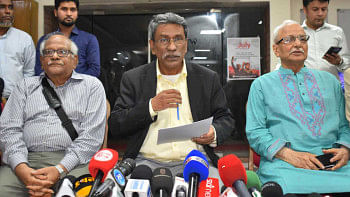Bringing in citizens’ voices in decision making: The DIMAPPP experience

In June 2019, the members of a citizen group in Jessore's Keshabpur upazila called their upazila engineer to inform him that the contractor who was building their village road brought low-quality bricks for the purpose, instead of the higher quality ones he was supposed to. The engineer promptly visited the site to verify the incident and ordered the removal of the bricks in question. The contractor complied. This was possible because of the unique model of citizen engagement the government has been implementing within the exemplary initiative Digitising Implementation Monitoring and Public Procurement Project (DIMAPPP).
The Central Procurement Technical Unit (CPTU) of the Government of Bangladesh (GoB) was awarded the prestigious World Bank's Directors Award on March 23—a fitting coincidence with Bangladesh's 50th Independence Day celebrations—as recognition for its leadership in institutionalising a highly innovative and citizen-friendly public procurement practice in the country through DIMAPPP. According to the World Bank award committee, the project is a "most innovative, collaborative and impactful governance global practice operation". While we celebrate the achievement, it is useful to look back and reflect on its journey to understand the process better, recognise the factors behind its success, and identify the remaining challenges in the domain of public procurement in the country.
As of Fiscal Year (FY) 2019-20, the government of Bangladesh spent about 85 percent of its annual development budget on public procurement, which is 45 percent of its annual budget and eight percent of GDP. Better governance of this greatly consequential process is vital for using public money more effectively and accelerating economic growth and enhancing citizen welfare.
In the GoB initiated public procurement reforms in 2002 through the Public Procurement Reform Project (PPRP), the development partners, especially the World Bank, played an important role in this process by providing technical support and funding. In two phases of the PPRP, the government made far-reaching legal and administrative reforms. It created the Central Procurement Technical Unit (CPTU) as a nodal body to steer the reform, developed and operationalised a unified legal procurement framework, and strengthened the management capacity of the procurement entities. All these initiatives were aimed at ensuring transparency, accountability, fairness, and better value for money in the procurement processes. Introducing digitised or the electronic government procurement (e-GP) system has been another crucial piece in achieving the aims of the reform. Last but not the least, the reform attempted to institutionalise the voices of the citizens, arguably the most important but generally ignored actor in the system, by allowing them to engage in monitoring development projects.
Despite some challenges, e-GP has so far improved the transparency and efficiency of the procurement process and, more importantly, enhanced competition in procurement with the participation of more tenderers. Consequently, it improved the timeliness of procurement and reduced the costs. According to a recent World Bank report, procurement costs in e-GP have decreased by 13 to 20 percent compared to those in manual procurement. BRAC Institute of Governance and Development (BIGD) conducted a cost-benefit analysis of using e-GP over manual procurement and found that it is one of the most cost-effective investments for the government. Given the amount spent on public procurement in Bangladesh, e-GP thus holds astronomical potential benefits.
The government started DIMAPPP, the award-winning project, in July 2017 with an objective of overall improvement in public procurement management. The project also aims to expand the depth of e-GP by developing and adopting the electronic contract management system and digitising the project monitoring process. Institutionalising citizen engagement in the public procurement process is yet another crucial DIMAPP agenda for fulfilling the aims of the overall reform.
BIGD has long been engaged in this reform process; particularly, it has been playing an instrumental role in developing a model for citizen engagement in the public procurement process. DIMAPPP is now implementing the model in 48 upazilas through BIGD, which has partnered with BRAC's Community Empowerment Program (CEP) for field implementation. In this model, local citizens are mobilised to monitor construction projects or contracts in their locality. To do this, engineers of the local procurement entities form site-specific local citizen groups and provide relevant information and quick orientation to the group on elementary evaluation skills for judging the quality of the projects. The groups monitor the projects and inform the authority if they find any irregularity.
Through this initiative, 285 small-scale development contracts on road, primary and secondary school, bridges, and upazila and UP complexes were brought under citizens' monitoring as of March 2021. The responsiveness of the local procurement agencies also helped. So far, citizens raised 253 complaints, out of which 236 have been resolved. The local Government Engineering Department (LGED) is the key agency which welcomed this innovative strategy. More recently, other procurement entities such as the Education Engineering Department and the Health Engineering Department also agreed to try out this citizens' monitoring model in their local projects.
The citizen engagement component has played a critical role in paving the way for bringing in the voice of the citizen in the public procurement system. Simultaneously, it created an opportunity to demonstrate how research can help effective policymaking. In 48 DIMAPPP intervention upazilas, with support from CPTU, BIGD has been systematically evaluating the process to understand it better, identify specific pain points, and suggest improvements. Besides, BIGD is carrying out a rigorous impact evaluation, a randomised control trial, to determine if this model of citizen monitoring makes a difference in the project quality. The government and the global public procurement community can use these research findings in the future to make informed decisions in scaling up or replicating the model.
As we have graduated to a middle-income country, it is critical that government policymakers increasingly rely on high-quality research evidence for decision making. We believe innovative initiatives like DIMAPPP will indeed act as a role model for effective policymaking using research, helping us realise the cherished dream of a prosperous Bangladesh.
Mohammed Shoheler Rahman Chowdhury is Director General of the Central Procurement Technical Unit (CPTU) and Dr Imran Matin is Executive Director of BRAC Institute of Governance and Development (BIGD).

 For all latest news, follow The Daily Star's Google News channel.
For all latest news, follow The Daily Star's Google News channel. 



Comments